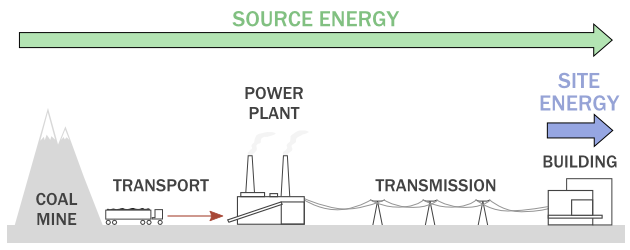Keeping track of energy use is important, not only for budgeting purposes but to establish benchmarks that are used to gauge future reductions in energy usage. In order to evaluate energy use and how to increase its production and delivery efficiency it is important to identify the different types of energy. Below we will explore the differences between the two primary divisions of energy: site vs source energy.
Another important thing to consider is the energy use intensity of the building, but that is a topic for another article.
Site Energy
Site energy is the energy which is consumed at the final destination of the power generation cycle, and to simplify, is the amount of energy shown on a utility bill. It is the power that is used by the customer, whether residential, commercial, or industrial. The site energy for a building is all of the energy used in the building - plug loads, lighting loads, all equipment power (gas, electric, etc) - as calculated by meters on site.
Once energy reaches its final source and becomes site energy, its use is evaluated based on the amount of that energy that is converted to useful power and the amount that is wasted. For example, when evaluating the use of water heaters, the efficiency (also known as an energy factor or EF) of a gas water heater is around 60%. In comparison, an electrical water heater has an EF in the range of 90%. What this means, simply, is that operation of a gas water heater will result in 60% of the gas effectively heating the water while 40% is wasted due to equipment inefficiencies. In the electric water heater only 10% of the energy is wasted. In order to reduce the amount of site energy used, it is important to identify inefficiencies in the equipment that uses the received power and either adjust the equipment operation or purchase more efficient equipment.
The key with site energy is that it focuses on the final use only. Source energy, on the other hand, takes into account the entire train of power from creation to distribution and through to the use of energy by the consumer, which we know as site energy.

Source Energy
Source energy includes the site energy plus all of the energy used to provide and distribute the site energy. As stated before, it includes the entire chain of energy so it is often called Total Energy.
Source energy is sub-divided into two major components: primary energy and secondary energy. Primary energy is the raw material that is consumed in order to create the power that is then distributed to consumers. The power that enters the distribution system is known as secondary energy – it is the energy that results from the transformation of the primary energy. Examples of primary energy are coal, natural gas and wood, while examples of secondary energy are electricity and steam.
Units of primary energy and secondary energy are not directly comparable, since one is generated from raw material and the other is the result of that generation. To achieve parity, the secondary energy is converted into units of raw material so that a comparison can be made to primary energy. Losses that result from the production, transmission, storage and/or delivery of the energy must be accounted for when determining the total value of the source energy.
Site-to-Source Ratio
Once the calculations have been completed and the total amount of source energy determined, the amount of source energy vs. site energy can be evaluated. A typical unit of measurement is the site-to-source ratio, which is simply the amount of energy used compared to the amount of energy consumed to create that power. In this case the lower the number the better.
Energy that is purchased from the electrical grid typically has a site-to-source ratio of around 2.8 in the United States, meaning that it requires 2.8 units of energy consumed in the generation and delivery process to deliver one unit of energy to the site. Much of this discrepancy is due to the significant amount of losses that occur in the electrical distribution process, also known as transmission loss. In contrast, natural gas provides a site-to-source ratio of approximately 1.05, meaning that the energy consumed through generation of the power is virtually equivalent to the energy distributed to the end user, with very minor losses along the way.
From this perspective, it can be seen that evaluating energy use simply based on equipment efficiencies does not allow us to see the entire picture. As discussed above, a gas water heater has an energy factor of 60% versus that of an electrical water heater, which has an energy factor of 90%. However, it takes almost 3 times as much energy in the electrical generation process to create one unit of usable energy than it does for natural gas. Therefore, the entire process of energy distribution and consumption, the source energy, must be looked at to provide a clear way of determining the most efficient means of energy production and use.
This PDF from Energy Star includes a list of different site-to-source ratios.


